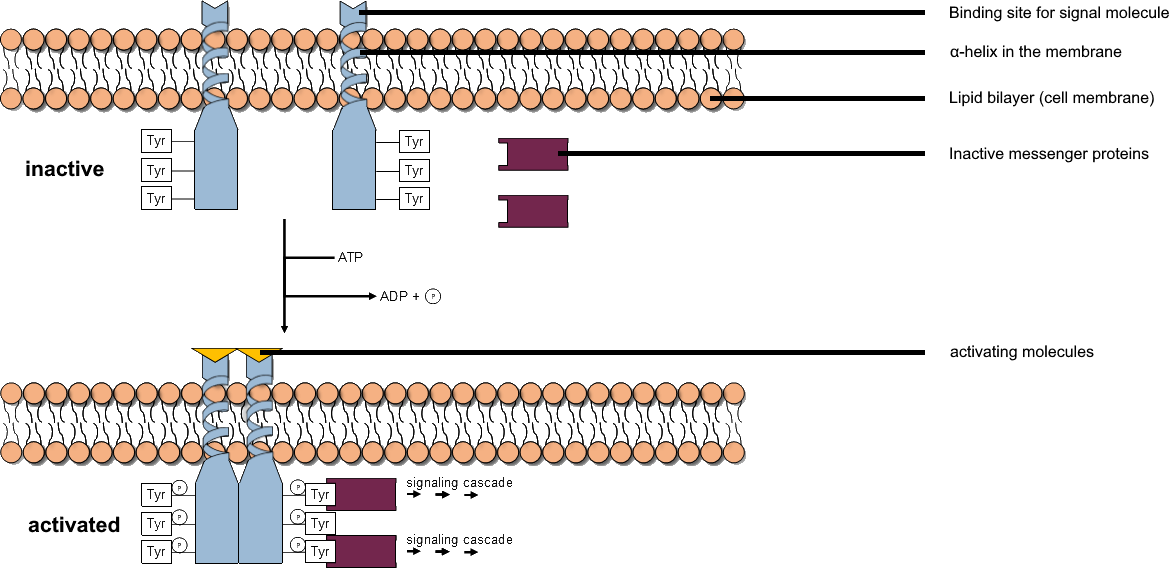|
FLT4
Fms-related tyrosine kinase 4, also known as FLT4, is a protein which in humans is encoded by the ''FLT4'' gene. This gene encodes a tyrosine kinase receptor for vascular endothelial growth factors C and D. The protein is thought to be involved in lymphangiogenesis and maintenance of the lymphatic endothelium. Mutations in this gene cause hereditary lymphedema type IA. Interactions FLT4 has been shown to interact with SHC1. See also * VEGF receptors VEGF receptors (VEGFRs) are receptors for vascular endothelial growth factor (VEGF). There are three main subtypes of VEGFR, numbered 1, 2 and 3. Depending on alternative splicing, they may be membrane-bound (mbVEGFR) or soluble (sVEGFR). ... References Further reading * * * * * * * * * * * * * * * * * * * External links GeneReviews/NCBI/NIH/UW entry on Milroy Disease Tyrosine kinase receptors {{membrane-protein-stub ... [...More Info...] [...Related Items...] OR: [Wikipedia] [Google] [Baidu] |
VEGF Receptors
VEGF receptors (VEGFRs) are receptors for vascular endothelial growth factor (VEGF). There are three main subtypes of VEGFR, numbered 1, 2 and 3. Depending on alternative splicing, they may be membrane-bound (mbVEGFR) or soluble (sVEGFR). Inhibitors of VEGFR are used in the treatment of cancer. VEGF Vascular endothelial growth factor (VEGF) is an important signaling protein involved in both vasculogenesis (the formation of the circulatory system) and angiogenesis (the growth of blood vessels from pre-existing vasculature). As its name implies, VEGF activity is restricted mainly to cells of the vascular endothelium, although it does have effects on a limited number of other cell types (e.g. stimulation monocyte/macrophage migration). ''In vitro'', VEGF has been shown to stimulate endothelial cell mitogenesis and cell migration. VEGF also enhances microvascular permeability and is sometimes referred to as vascular permeability factor. Receptor biology All members of the ... [...More Info...] [...Related Items...] OR: [Wikipedia] [Google] [Baidu] |
Tyrosine Kinase
A tyrosine kinase is an enzyme that can transfer a phosphate group from ATP to the tyrosine residues of specific proteins inside a cell. It functions as an "on" or "off" switch in many cellular functions. Tyrosine kinases belong to a larger class of enzymes known as protein kinases which also attach phosphates to other amino acids such as serine and threonine. Phosphorylation of proteins by kinases is an important mechanism for communicating signals within a cell (signal transduction) and regulating cellular activity, such as cell division. Protein kinases can become mutated, stuck in the "on" position, and cause unregulated growth of the cell, which is a necessary step for the development of cancer. Therefore, kinase inhibitors, such as imatinib and osimertinib, are often effective cancer treatments. Most tyrosine kinases have an associated protein tyrosine phosphatase, which removes the phosphate group. Reaction Protein kinases are a group of enzymes that possess a ca ... [...More Info...] [...Related Items...] OR: [Wikipedia] [Google] [Baidu] |
Vascular Endothelial Growth Factor
Vascular endothelial growth factor (VEGF, ), originally known as vascular permeability factor (VPF), is a signal protein produced by many cells that stimulates the formation of blood vessels. To be specific, VEGF is a sub-family of growth factors, the platelet-derived growth factor family of Cystine knot, cystine-knot growth factors. They are important signaling proteins involved in both vasculogenesis (the ''De novo synthesis, de novo'' formation of the embryonic circulatory system) and angiogenesis (the growth of blood vessels from pre-existing vasculature). It is part of the system that restores the oxygen supply to tissues when blood circulation is inadequate such as in hypoxic conditions. Serum concentration of VEGF is high in bronchial asthma and diabetes mellitus. VEGF's normal function is to create new blood vessels during embryonic development, new blood vessels after injury, muscle following exercise, and new vessels (collateral circulation) to bypass blocked vessels. It ... [...More Info...] [...Related Items...] OR: [Wikipedia] [Google] [Baidu] |
Vascular Endothelial Growth Factor C
Vascular endothelial growth factor C (VEGF-C) is a protein that is a member of the platelet-derived growth factor / vascular endothelial growth factor (PDGF/VEGF) family. It is encoded in humans by the ''VEGFC'' gene, which is located on chromosome 4q34. Functions The main function of VEGF-C is to promote the growth of lymphatic vessels ( lymphangiogenesis). It acts on lymphatic endothelial cells (LECs) primarily via its receptor VEGFR-3 promoting survival, growth and migration. It was discovered in 1996 as a ligand for the orphan receptor VEGFR-3. Soon thereafter, it was shown to be a specific growth factor for lymphatic vessels in a variety of models. However, in addition to its effect on lymphatic vessels, it can also promote the growth of blood vessels and regulate their permeability. The effect on blood vessels can be mediated via its primary receptor VEGFR-3 or its secondary receptor VEGFR-2. Apart from vascular targets, VEGF-C is also important for neural development a ... [...More Info...] [...Related Items...] OR: [Wikipedia] [Google] [Baidu] |
Vascular Endothelial Growth Factor D
C-fos-induced growth factor (FIGF) (or vascular endothelial growth factor D, VEGF-D) is a vascular endothelial growth factor that in humans is encoded by the ''FIGF'' gene In biology, the word gene has two meanings. The Mendelian gene is a basic unit of heredity. The molecular gene is a sequence of nucleotides in DNA that is transcribed to produce a functional RNA. There are two types of molecular genes: protei .... Function The protein encoded by this gene is a member of the platelet-derived growth factor/vascular endothelial growth factor (PDGF/VEGF) family and is active in angiogenesis, lymphangiogenesis, and endothelial cell growth. This secreted protein undergoes a complex proteolytic maturation, generating multiple processed forms that bind and activate VEGFR-2 and VEGFR-3 receptors. The structure and function of this protein is similar to those of vascular endothelial growth factor C. Tumor metastasis to lymph nodes Lymph node metastasis is very often associ ... [...More Info...] [...Related Items...] OR: [Wikipedia] [Google] [Baidu] |
Protein
Proteins are large biomolecules and macromolecules that comprise one or more long chains of amino acid residue (biochemistry), residues. Proteins perform a vast array of functions within organisms, including Enzyme catalysis, catalysing metabolic reactions, DNA replication, Cell signaling, responding to stimuli, providing Cytoskeleton, structure to cells and Fibrous protein, organisms, and Intracellular transport, transporting molecules from one location to another. Proteins differ from one another primarily in their sequence of amino acids, which is dictated by the Nucleic acid sequence, nucleotide sequence of their genes, and which usually results in protein folding into a specific Protein structure, 3D structure that determines its activity. A linear chain of amino acid residues is called a polypeptide. A protein contains at least one long polypeptide. Short polypeptides, containing less than 20–30 residues, are rarely considered to be proteins and are commonly called pep ... [...More Info...] [...Related Items...] OR: [Wikipedia] [Google] [Baidu] |
Gene
In biology, the word gene has two meanings. The Mendelian gene is a basic unit of heredity. The molecular gene is a sequence of nucleotides in DNA that is transcribed to produce a functional RNA. There are two types of molecular genes: protein-coding genes and non-coding genes. During gene expression (the synthesis of Gene product, RNA or protein from a gene), DNA is first transcription (biology), copied into RNA. RNA can be non-coding RNA, directly functional or be the intermediate protein biosynthesis, template for the synthesis of a protein. The transmission of genes to an organism's offspring, is the basis of the inheritance of phenotypic traits from one generation to the next. These genes make up different DNA sequences, together called a genotype, that is specific to every given individual, within the gene pool of the population (biology), population of a given species. The genotype, along with environmental and developmental factors, ultimately determines the phenotype ... [...More Info...] [...Related Items...] OR: [Wikipedia] [Google] [Baidu] |
Lymphangiogenesis
Lymphangiogenesis is the formation of lymphatic vessels from pre-existing lymphatic vessels in a method believed to be similar to angiogenesis (blood vessel development). Lymphangiogenesis plays an important physiological role in homeostasis, metabolism and immunity. Impaired or excessive lymphatic vessel formation has been implicated in a number of pathological conditions including neoplasm metastasis, oedema, rheumatoid arthritis, psoriasis, lymphangiomatosis and impaired wound healing. The role of the lymphatic system The lymphatic system, or lymphoid system, is an organ system in vertebrates that is part of the immune system and complementary to the circulatory system. It consists of a large network of lymphatic vessels, lymph nodes, lymphoid organs, lympha ... in these diseases has received renewed interest largely due to the discovery of lymphatic endothelial cell (LEC)-specific markers such as podoplanin, LYVE-1, PROX1, desmoplakin and VEGF-C receptor VEGFR ... [...More Info...] [...Related Items...] OR: [Wikipedia] [Google] [Baidu] |
Lymphedema
Lymphedema, also known as lymphoedema and lymphatic edema, is a condition of localized edema, swelling caused by a compromised lymphatic system. The lymphatic system functions as a critical portion of the body's immune system and returns interstitial fluid to the bloodstream. Lymphedema is most frequently a complication of cancer treatment or parasitic infections, but it can also be seen in a number of genetic disorders. Tissues with lymphedema are at high risk of infection because the lymphatic system has been compromised. Though incurable and progressive, a number of treatments may improve symptoms. This commonly includes compression therapy, good skin care, exercise, and manual lymphatic drainage (MLD), which together are known as combined decongestive therapy. Diuretics are not useful. Signs and symptoms The most common manifestation of lymphedema is soft tissue swelling (edema). As the disorder progresses, worsening edema and skin changes including discoloration, verr ... [...More Info...] [...Related Items...] OR: [Wikipedia] [Google] [Baidu] |
SHC1
SHC-transforming protein 1 is a protein that in humans is encoded by the ''SHC1'' gene. SHC has been found to be important in the regulation of apoptosis and drug resistance in mammalian cells. SCOP A ( or ) was a poet as represented in Old English poetry. The scop is the Old English counterpart of the Old Norse ', with the important difference that "skald" was applied to historical persons, and scop is used, for the most part, to designat ... classifies the 3D structure as belonging to the SH2 domain family. Gene and expression The gene SHC1 is located on chromosome 1 and encodes 3 main protein isoforms: p66SHC, p52SHC and p46SHC. These proteins differ in activity and subcellular locations, p66 is the longest and while the p52 and p46 link activated receptor tyrosine kinase to the RAS pathway. The protein SHC1 also acts as a scaffold protein which is used in cell surface receptors. The three proteins that SHC1 codes for have distinctly different molecular weights. All t ... [...More Info...] [...Related Items...] OR: [Wikipedia] [Google] [Baidu] |


